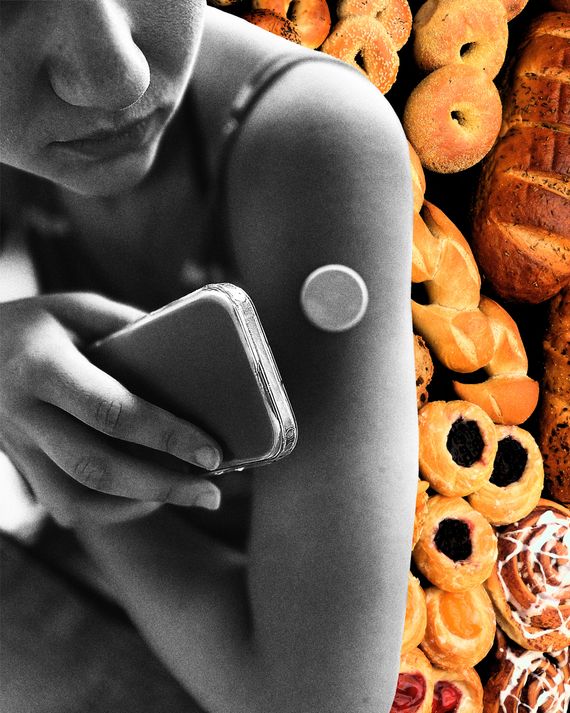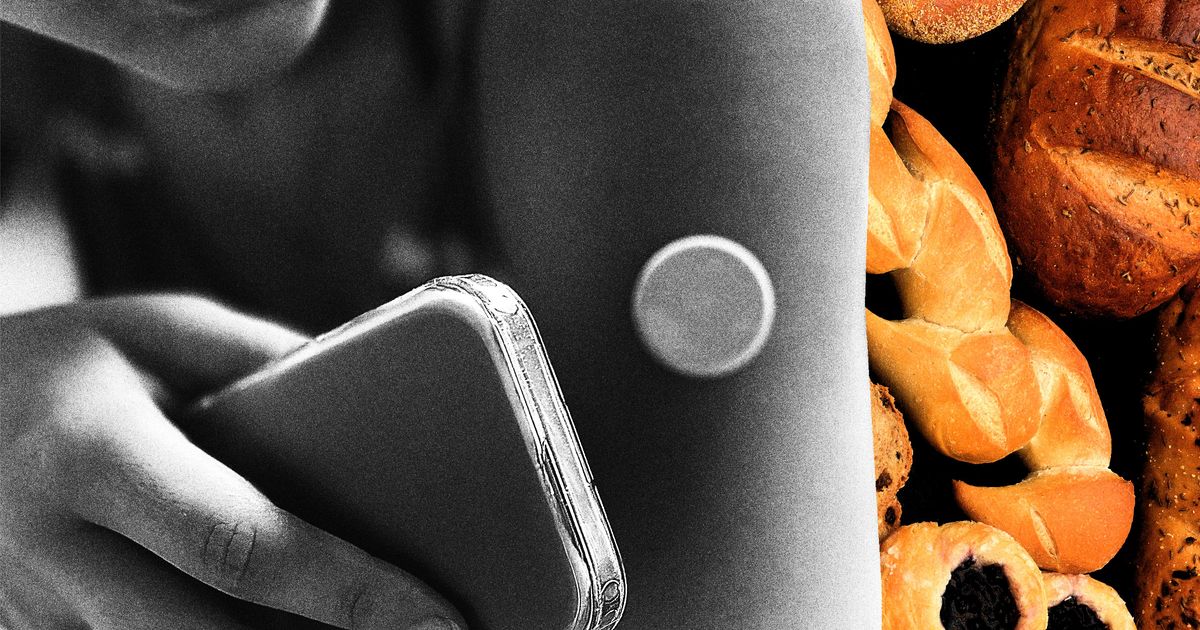
Photo-Illustration: The Cut; Photos Getty Images
If you were interested in receiving a seemingly endless stream of data about your bodily functions, it used to be enough to buy an Oura ring. Now, wellness obsessives are tracking their blood sugar around the clock, too. While continuous glucose monitors (CGMs) were initially intended to help people with diabetes manage their blood sugar, they’re now available over-the-counter for anyone curious about how their body is responding to their breakfast. My Instagram feed is full of ads for direct-to-consumer CGMs from brands like Lingo and Stelo. Gwyneth Paltrow recently filmed herself wearing one while making grain-free pancakes.
Proponents of CGMs will tell you that the main reason to wear one is to avoid “blood sugar spikes.” The influencer Jessie Inchauspé — known online as Glucose Goddess — has built a massive following based on her claims that blood-sugar fluctuations are terrible for your health even if you don’t have diabetes. In addition to causing excessive hunger, cravings, and fatigue, “each glucose spike,” Inchauspé claims, “increases heart-disease risk.” She says balancing your blood-sugar levels will help you avoid developing prediabetes and type 2 diabetes, and also reduce your risk of Alzheimer’s and cancer. She’s now an ambassador for Stelo, which makes a CGM specifically for people who don’t use insulin and claims that “keeping glucose levels stable is essential for maintaining your overall well-being.” Getting more people to use wearables to track their blood sugar is also apparently central to Robert F. Kennedy Jr.’s “vision” for how to make Americans healthier. Perhaps not coincidentally, Levels, one of the main companies pushing CGMs for people without diabetes, was founded by none other than Casey Means, Trump’s nominee for surgeon general. (Means has said she will sell her stake in Levels if she’s confirmed.) She believes that wearing a CGM can help you feel better, lose weight, and avoid developing a vast array of chronic illnesses.
Given all the hype, I wanted to try out the wearable for myself. I decided to try the Levels app, which Means has said she started after dropping out of her surgical residency in order to “empower people to make healthy choices on their own terms.” The app is designed to be connected with a Stelo CGM, which starts at $89 a month. While Stelo’s device comes with an app that displays your blood-sugar readings, for an additional $288 a year, Levels will interpret this data alongside information about your meals and exercise to provide AI-generated health guidance. After I downloaded the app and signed over my health data, my CGM arrived in the mail a few days later. Each sensor — which lasts about two weeks — comes with an applicator that uses a needle to insert a small wire just under your skin on the back of your upper arm. While this made me a little queasy, putting it on was relatively painless.
My CGM sent blood-sugar readings to my phone every 15 minutes, and the Levels app quickly got to work generating a complex graph of my fluctuations after each meal and snack. Admittedly, this is fun data to have — at least at first. The feeling that Casey Means was judging everything I put into my body motivated me to be on “good” behavior, avoiding sweets and eating chicken breast whenever I could. But it didn’t take long for the app to start getting on my nerves.
In the first few days of wearing a CGM, I lost track of how many times the Levels app informed me that my blood sugar was spiking. For people without diabetes, it’s considered normal for blood sugar to be anywhere between 70 and 140 mg/dL, says Danielle Shine, an accredited dietitian who researches nutrition misinformation at the University of Canberra. However, Levels apparently thinks that’s too lax. The app was concerned pretty much anytime my blood sugar was above 110 mg/dL, and it constantly sent me alarming messages about it. “Did something happen at 3:34 p.m.?” the app wanted to know after I ate a cookie. I did not appreciate getting a push notification reminding me that “some movement can help blunt the spike” while I was in the middle of putting my daughter to bed or sitting in a car on the highway — especially given that, most of the time, my blood sugar was still in the normal range.
To optimize its “insights,” the app also wanted me to log my meals. Levels claims to make macro tracking easier by having you take a picture of your food and then using AI to calculate the nutrition stats. But this feature could use some work. The app thought my morning yogurt with chia seeds, chopped apples, and nuts was “cream cheese with red pepper, bacon bits, and blue cheese,” a meal I’ve never eaten in my life. Another time, it thought the meal was “imitation crab salad.” It also didn’t seem to care about portion size, logging a slice of pizza and salad as 1,715 calories. (Apparently, it assumed I ate an entire pizza crust.)
Then there were the scores. Levels rates each meal on a scale from one to ten based on nutritional quality and glucose response. According to the app, meals with eggs, chicken, avocado, and nuts tend to score higher, while lower-scoring meals include cereal, noodles, and candy. These scores can be brutal. Thai takeout for dinner — chicken curry with rice and drunken noodles — earned me a one. “Big spike,” the app warned, recommending that next time I order out, I should “swap white rice for steamed vegetables.” On the other hand, eating a salad with grilled chicken and avocado for lunch only got a seven. The app also wasn’t that impressed when I ate Greek salad for dinner, suggesting that I “consider limiting higher-carb ingredients like chickpeas” in the future. Still, it was hard to take Levels’ recommendations too seriously, given that the same exact turkey wrap for lunch earned a nine (excellent) one day and a five (poor) another. After I logged an ice cream sandwich as a treat, the app thought I’d be interested to learn that ice cream is high in sugar, directing me to a list of low-carb alternatives. (Surprisingly, Levels said this post wasn’t sponsored.)
As much as the Levels app annoyed me, the constant alerts that my blood sugar was out of whack did stress me out. After a bowl of popcorn resulted in a “big spike,” I began to wonder if my cravings for “naked carbs” — Glucose Goddess’s term for when you eat starch or sugar without pairing it with protein and fat — were slowly killing me. But the dietitians I spoke with said that, for people without diabetes, obsessing over blood-sugar readings usually isn’t helpful. “It’s information overload,” says Shine. For nondiabetics, it’s normal for glucose to rise after a meal, and it typically returns to baseline within an hour or two. “That’s a healthy metabolic response.” (Levels did not respond to a request for comment.)
According to Shine, what Levels deems a “spike” is often just a normal fluctuation. In fact, she says the term “blood sugar spike” is rarely used in a clinical setting at all. (It’s worth noting that the American Diabetes Association doesn’t set post-meal glucose targets for people without diabetes, since it’s not recommended they routinely monitor their blood sugar.) While it’s true that meals that are heavy in refined carbs can make glucose levels rise higher and faster, Shine says that occasional readings above 140mg/dL usually aren’t cause for concern. “As a dietitian, I look at the bigger picture and the person’s overall dietary pattern,” she says.
The influencers pushing CGMs argue that every blood-sugar “spike” is dangerous. Mark Hyman, a functional-medicine doctor and adviser to Levels, claims that frequent spikes lead to insulin resistance and type 2 diabetes, and says that even sweet potatoes may need to be approached with caution. Glucose Goddess’s feed is full of warnings that having oatmeal for breakfast is a recipe for feeling tired and hungry all day. She claims the order in which you eat your food matters, and that you should have vegetables first to lower the spike. (She suggests that bread at restaurants is a conspiracy so that you’ll feel hungrier after your main course and order dessert.) Ideally, you’d go for a walk after every meal, but if you can’t manage that, she recommends you do some calf raises to “soak up the glucose.”
It’s hard to argue with the fact that pairing carbs with protein, fat, and fiber will keep you full longer — and keep your energy and mood stable, says Abby Langer, a registered dietitian. “Dietitians have been telling people to do that for years.” Going for a walk after eating is generally a good idea, too. But if you don’t have diabetes, you don’t need to manipulate your meals to avoid every possible “spike,” Langer says. Inspired by Glucose Goddess’s “hacks,” Shine says she’s had a number of clients who insist on eating chicken or an egg before having a cookie. “I always ask, Do you enjoy that? I have yet to hear anyone say yes.” While eating vegetables or protein first might result in slightly lower blood sugar, “for the average person, there’s no clinical relevance whatsoever,” says Langer.
It’s true that, in the long term, a diet that’s high in refined carbs, added sugar, and saturated fat can increase your risk of developing insulin resistance. But there’s no evidence that temporary “spikes” after carb-heavy meals cause insulin resistance in metabolically healthy people — or that keeping blood-glucose levels below 110mg/dL, as Levels recommends, improves long-term health outcomes, says Shine. That said, if your blood sugar is consistently above the normal range, that can signal impaired glucose tolerance — which should be assessed by a doctor, not the Levels app. CGMs aren’t approved for diagnosing prediabetes or diabetes, which requires validated lab tests conducted under medical supervision. And diet alone doesn’t determine your risk for developing diabetes, which has many contributing factors, including genetics, low physical activity, chronic poor sleep, chronic stress, smoking, long-term alcohol consumption, and excess body fat, says Shine.
Using Levels, it’s easy to get the impression that you should aim to keep your blood sugar as low as possible — but that really isn’t good for you. “I think CGMs should come with a warning label,” says Shine, who had one client who became so fixated on keeping her glucose levels down that she had to be hospitalized after fainting. (The same client also drank apple cider vinegar before meals — one of Glucose Goddess’s signature “hacks” to keep blood sugar down — which eroded the enamel on her teeth, Shine says.) “I think it can be profoundly damaging to our relationship with food and our bodies to drill everything down to numbers,” says Langer. “It creates this total disconnect between how we feel and what we want.”
By the end of two weeks, I was itching to rip my CGM off my arm and scrub away the grimy-looking residue from the adhesive. It was a joy to have a bowl of pasta without getting a scorecard afterwards — and I certainly don’t plan to keep paying $24 a month to have every snack judged by an app that can’t tell the difference between apples and bacon.
Stay in touch.
Get the Cut newsletter delivered daily
Vox Media, LLC Terms and Privacy Notice
Related

